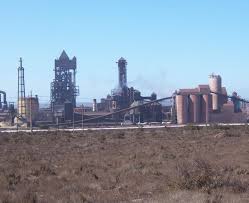This
article presents a quick review about some of the steel plants with COREX
process in operation especially, as how these COREX plants were started and subsequent
developments and changes brought in those COREX plants. Because of its
techno-commercial and ecological advantages the COREX Process, besides the
FINEX technology, is the only industrially accepted alternative to the blast
furnace route for the production of hot metal. Current COREX pre-projects also
indicate an existing demand for the “by-product” COREX gas for power generation
and for the production of DRI. You may also like to read: COREX Process ofIron Making - its Merits and Demerits
Steel Plants with COREX Process in Operation
ArcelorMittal
Steel, Saldanha Works, South Africa
Plant highlights / developments:
- The COREX plant
operation is based on approx. 80% local lump ore charging.
- Typical annual
production for the COREX / MIDREX DR plant combination is 700,000 t/a HM
and 700,000 t/a DRI.
- Compared to other
ArcelorMittal steel plants, this steel works is within the plants with the
lowest production cost.
JSW Steel, Toranagallu Works, Bellary, Karnataka,
India
Considering the importance of
environment protection, resource conservation and sustainable development in
India, JSW Steel (formerly, Jindal Vijaynagar Steel Ltd) opted for COREX technology
(COREX + BOF route) for its integrated iron making project. JSW Steel (India) has two COREX C-2000 and one combined COREX gas based MIDREXTM DR plant. Start-up of COREX C-2000 plant Module 01
and 02 took place in 1999 and in 2001 respectively. This process allowed
greater flexibility of operation as well as use of non-coking coals as a
primary fuel and raw materials of less stringent quality. Some of the special
features of COREX hot metal are high temperature (1480 - 1510OC),
low sulphur, low nitrogen and least amount of impurities. This has proved to be
more eco-friendly as compared to the conventional blast furnace route due to the exclusion of sinter plant and coke
ovens. Recycling of the most of the metallurgical
wastes such as coke fines, mill scale, iron ore fines, LD slag, Limestone
and Dolomite fines etc. are done as a COREX burden feedstock.
 |
- In 2014 a COREX gas based 1.2 million t/a MIDREX DR plant was successfully added to produce Hot DRI.
- COREX gas from both modules is partly used for Hot DRI production which is subsequently transferred to a new adjacent EAF steel plant via a hot transport system. The remaining export gas is still used for internal steel works use, the pelletizing plant and the power plant for co-firing.
- A recovery in excess of 95% of COREX slag could be done through slag granulation plant and is used in the manufacture of cement.
- Jindal’s COREX plant has been able to surpass its rated capacity by more than 20 - 25%, producing quality hot metal for steelmaking.
- During the relining in 2012 and 2013 an Arial Gas Distribution System was introduced in the reduction shaft of each COREX module. As a result of new developments (more even gas distribution, less burden weight on the DRI screws, more even flow of the material through the reduction shaft, etc.) an improvement of the process itself could be achieved: (a) Improved gas distribution, (b) Lower dp over the reduction shaft (c) Significant increase in Shaft Lifetime - the time from one shaft cleaning to the next shaft cleaning that occurred at JSW Steel on a regular basis has now been elongated to more than one year.
Further developments:
- In 2002 the COREX
plant of POSCO, Pohang Works was converted into the FINEX F-0.6M.
- Demonstration Plant
with a nominal capacity of 2000 t/d commenced operation in 2003.
- In July 2014 the operation was stopped and
currently it is under investigation to relocate the plant to India.
Further developments:
- Due to declining prices for heavy plate and as
part of a strategic realignment of production in the Shanghai area,
Baosteel decided to cease steel production in the Luojing Works and
dismantle the individual steelmaking installations, including the two COREX
plants. It rebuilt the dismantled installations in various Chinese steel
works. The COREX Module 01 has been transferred to Bayi Iron & Steel
Co Limited in the Xinjiang Province, a steelmaker belonging to the
Baosteel Group.
- The COREX plant at Bayi Steel will allow local
coal to be used, which are significantly cheaper in Xinjiang area.
- COREX gas can be used as a fuel gas in the
downstream facilities to generate electricity or for the production of
direct-reduced iron in a region that has almost no resources of natural
gas.
Essar Hazira Ltd. India
Essar
Hazira Ltd. relocated the two COREX plants (C-2000) from former Hanbo, Korea to
their steelworks in Hazira, near Surat in Gujarat, India. The first plant has
been started-up successfully in August 2011. Start-up of the second plant took
place in December 2011. The COREX gas is mainly utilized at the existing MIDREX
DR Modules to minimize natural gas consumption and for internal heating
purposes.








